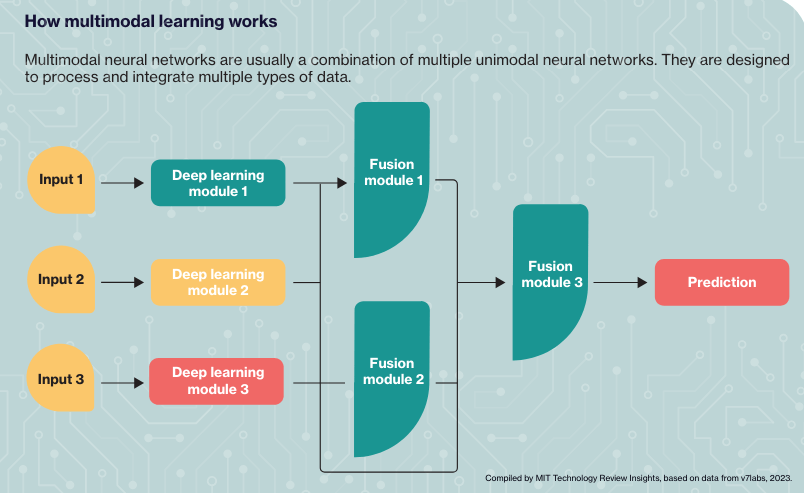
Why Building Multi-Agent AI Systems for your FSI Isn’t Always the Answer (& How to Approach it When it is)
Learn how to build a multi-agent AI system that handles complex FSI workflows with secure architecture and sector-specific logic.
Much of the dialogue around generative AI has focussed on single-model LLMs – for example, text-based models, such as the original version of ChatGPT publicly released 18 months ago.
Earlier this month (just one day apart), OpenAI and Google changed the conversation by showcasing multimodal AI with GPT-4 Omni and Project Astra, respectively. Meanwhile, many of Amazon’s AWS AI services, such as Amazon Titan, also include multimodal capabilities.
Single or unimodal text-to-text LLMs can only analyze users’ written prompt engineering commands to provide word-form answers. However, multimodal AI is capable of both receiving prompts and providing answers using images, audio, and video, as well as text, at the same time.
As we’ll explore throughout this article, these multimodal capabilities significantly expand the already extensive range of GenAI use cases.
Therefore, the global multimodal AI market should grow rapidly in the coming years. According to MIT Technology Review Insights, the multimodal AI market of solutions and services could grow at an average annual rate of 32.2% until 2030, reaching an estimated total value of $8.4 billion.

Using multimodal GenAI has the potential to provide significant benefits for enterprises across all industries. It offers opportunities to improve both front-office services by improving customer experiences and back-office functions through greater operational efficiency.
Aware of the benefits, 67% of enterprise tech executives are prioritizing investments in GenAI, according to a report from Bain.

Multimodal AI can process and integrate information from multiple modalities or sources – such as text, images, audio, video, and other forms of data. At the core of multimodal AI are models that can process different data types or modalities.
For example, natural language processing (NLP) models handle text data, computer vision models process images and videos, and speech recognition models convert audio into text. But what makes multimodal AI unique is the ability to combine and fuse the outputs from these different models.
There are three main components:

The central multimodal fusion component integrates the information from the different inputs, resolving any conflicts or ambiguities before generating a unified multimodal response.
This fusion component can combine information from different modalities using techniques such as deep learning neural networks or rule-based systems. It can also leverage contextual information to understand the user’s intent better, producing more relevant and coherent responses.
With multimodal generative AI able to process and analyze business data in different formats, there is vast potential for efficiency and cost savings throughout the supply chain. It can also optimize customer-facing operations in many ways.
Here are just a few example use cases for enterprises:
Multimodal generative AI can optimize supply chain processes by analyzing multimodal data to provide real-time insights into inventory management, demand forecasting, and quality control.
It has the potential to optimize inventory levels by recommending ideal stock quantities based on demand forecasts, lead times, and warehouse capacities. By analyzing equipment sensor data and maintenance logs, it can also provide predictive maintenance schedules.
Training an LLM on manufacturing data, reports, and customer feedback can optimize the design process.
Multimodal AI can also provide predictive maintenance capabilities and analyze market trends, informing future product design.
Simultaneously analyzing text, images, and voice data, multimodal generative AI can provide more context-aware and personalized responses, improving the customer experience.
By including visual and contextual information, multimodal AI assistants can understand and respond to customer queries in a more human way.
Multimodal LLMs can quickly co-develop dynamic marketing campaigns by integrating audio, images, video, and text.
In a McKinsey survey of senior sales and marketing executives, some of the key use cases they identified for GenAI include lead identification, marketing tactic optimization and personalized outreach.

Here are just a few ways multimodal AI can provide benefits in different sectors:
By combining medical images with patient records and genetic data, healthcare providers can gain a more accurate understanding of a patient’s health.
This offers the potential to more efficiently tailor treatment plans to individual patients based on multiple data sources.
GenAI can reduce the administrative burden for healthcare professionals in many ways, leading to more time spent with patients and better outcomes. Find out how Intelligent Document Processing (IDP) helped Treatline reduce time spent on administration by 70%.
Multimodal AI can feature in solutions that:
In a recent AWS Machine Learning Blog post, a team of experts explored this in detail.

In retail, use cases include letting customers interact with an LLM through voice, text, and images to receive personalized product recommendations and assistance with purchases.
By combining customer data (including purchase history, preferences, and browsing behavior) with multimedia content (such as product images and videos), multimodal LLMs can generate product recommendations and highly personalized marketing campaigns.
In manufacturing, multimodal AI use cases include:
Potential benefits include:
Overall, multimodal LLMs have the means to provide unprecedented efficiency for enterprises by significantly streamlining work and empowering better resource allocation.
While these are manageable, considerable expertise is required to address the following challenges when using multimodal AI.
Multimodal generative AI has the potential to provide major benefits for enterprises across all industries.
It provides opportunities to optimize front-office services by improving customer experiences and offering unprecedented personalization. There is a direct link to revenue here – companies with the best customer experience bring in 5.7 times more revenue than others, according to Forbes.
Multimodal generative AI can also transform back office functions through greater operational efficiency, optimizing costs.
These benefits align closely with the main focuses of enterprises’ GenAI initiatives, based on a recent Gartner survey:

Multimodal generative AI has a wide range of use cases, but each business and its sector will have a different specific area with the highest likely return on investment.
This could involve automating and accelerating operations or delivering cutting-edge personalization and experiences to customers.
If you’re not sure how to get started, Neurons Lab can help. With our GenAI Workshop and Proof of Concept service, 75-100% funded by AWS, we turn your ideas into detailed strategies and tactics. We build a working proof of concept to validate assumptions and reduce risk when investing in GenAI technology.
To discuss how we can help you gain a competitive edge with GenAI, please get in touch.
Neurons Lab delivers AI transformation services to guide enterprises into the new era of AI. Our approach covers the complete AI spectrum, combining leadership alignment with technology integration to deliver measurable outcomes.
As an AWS Advanced Partner and GenAI competency holder, we have successfully delivered tailored AI solutions to over 100 clients, including Fortune 500 companies and governmental organizations.
Learn how to build a multi-agent AI system that handles complex FSI workflows with secure architecture and sector-specific logic.
Agentic AI in banking customer service enhances CSAT, FCR, and compliance by scaling your top rep's knowledge across the team.
Discover the essential roles in an AI development team and how to scale AI capability in financial services with the right strategy.
Discover AI’s full potential in wealth management—streamline workflows, boost client engagement, and scale AUM with compliant, tailored solutions
Discover the top AI agent development services for FSI, healthcare & more in 2025. Find your ideal partner for custom, compliant AI agents





